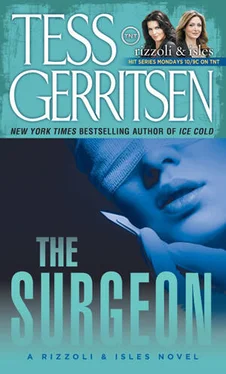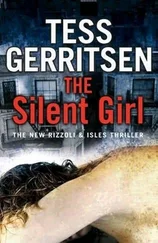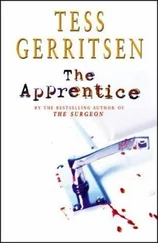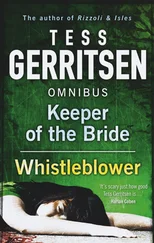“Enjoying himself,” said Moore softly.
“You mean, like jerking off?” said Darren Crowe, posing the question with his usual crudeness.
“There was no ejaculate left at either crime scene,” pointed out Rizzoli.
Crowe tossed her an aren’t you smart look. “The absence of e-jac-u-late ,” he said, sarcastically emphasizing every syllable, “doesn’t rule out jerking off.”
“I don’t believe he was masturbating,” said Zucker. “This particular unsub would not relinquish that much control in an unfamiliar environment. I think he waits until he’s in a safe place to achieve sexual release. Everything about the crime scene screams control . When he proceeds to the final act, he does it with confidence and authority. He cuts the victim’s throat with a single deep slash. And then he performs one last ritual.”
Zucker reached into his briefcase and took out two crime scene photos, which he laid on the table. One was of Diana Sterling’s bedroom, the other of Elena Ortiz’s.
“He meticulously folds their nightclothes and places them near the body. We know the folding was done after the slaughter, because blood splatters were found on the inside folds.”
“Why does he do that?” asked Frost. “What’s the symbolism there?”
“Control again,” said Rizzoli.
Zucker nodded. “That’s certainly part of it. By this ritual, he demonstrates he’s in control of the scene. But at the same time, the ritual controls him . It’s an impulse he may not be able to resist.”
“What if he’s prevented from doing it?” asked Frost. “Say he’s interrupted and can’t complete it?”
“It will leave him frustrated and angry. He may feel compelled to immediately start hunting for the next victim. But so far, he’s always managed to complete the ritual. And each killing has been satisfying enough to tide him over for long periods of time.” Zucker looked around the room. “This is the worst kind of unsub we can face. He went a whole year between attacks — that’s extremely rare. It means he can go months between hunts. We could run ourselves ragged looking for him, while he sits patiently waiting for the next kill. He is careful. He is organized. He will leave few, if any, clues behind.” He glanced at Moore, seeking confirmation.
“We have no fingerprints, no DNA, at either crime scene,” Moore said. “All we have is a single strand of hair, collected from Ortiz’s wound. And a few dark polyester fibers from the window frame.”
“I take it you’ve found no witnesses, either.”
“We had thirteen hundred interviews on the Sterling case. One hundred eighty interviews so far on the Ortiz case. No one saw the intruder. No one was aware of any stalker.”
“But we have had three confessions,” said Crowe. “They all walked in off the street. We took their statements and sent them on their way.” He laughed. “Wackos.”
“This unsub is not insane,” said Zucker. “I would guess he appears perfectly normal. I believe he’s a white male in his late twenties or early thirties. Neatly groomed, of above-average intelligence. He is almost certainly a high school graduate, perhaps with a college education or even more. The two crime scenes are over a mile apart, and the murders were committed at a time of day when there was little public transportation running. So he drives a car. It will be neat and well maintained. He probably has no history of mental health problems, but he may have a juvenile record of burglary or voyeurism. If he’s employed, it will be a job that requires both intelligence and meticulousness. We know he is a planner, as demonstrated by the fact he carries his murder kit with him — scalpel, suture, duct tape, chloroform. Plus a container of some kind in which to bring his souvenir home. It could be as simple as a Ziploc bag. He works in a field that requires attention to detail. Since he obviously has anatomical knowledge, and surgical skills, we could be dealing with a medical professional.”
Rizzoli met Moore’s gaze, both struck by the same thought: There were probably more doctors per capita in the city of Boston than anywhere else in the world.
“Because he is intelligent,” said Zucker, “he knows we’re staking out the crime scenes. And he will resist the temptation to return. But the temptation is there, so it’s worth continuing the stakeout of Ortiz’s residence, at least for the near future.
“He is also intelligent enough to avoid choosing a victim in his immediate neighborhood. He’s what we call a ‘commuter,’ rather than a ‘marauder.’ He goes outside his neighborhood to hunt. Until we have more data points to work with, I can’t really do a geographical profile. I can’t pinpoint which areas of the city you should focus on.”
“How many data points do you need?” asked Rizzoli.
“A minimum of five.”
“Meaning, we need five murders?”
“The criminal geographic targeting program I use requires five to have any validity. I’ve run the CGT program with as few as four data points, and sometimes you can get an offender residence prediction with that, but it’s not accurate. We need to know more about his movements. What his activity space is, where his anchor points are. Every killer works inside a certain comfort zone. They’re like carnivores hunting. They have their territory, their fishing holes, where they find their prey.” Zucker looked around the table at the detectives’ unimpressed faces. “We don’t know enough about this unsub yet to make any predictions. So we need to focus on the victims. Who they were, and why he chose them.”
Zucker reached into his briefcase and took out two folders, one labeled Sterling , the other Ortiz . He produced a dozen photographs, which he spread out on the table. Images of the two women when they were alive, some dating all the way back to childhood.
“You haven’t seen some of these photos. I asked their families to provide them, just to give us a sense of the history of these women. Look at their faces. Study who they were as people. Why did the unsub choose them ? Where did he see them? What was it about them that caught his eye? A laugh? A smile? The way they walked down a city street?”
He began to read from a typewritten sheet.
“Diana Sterling, thirty years old. Blond hair, blue eyes. Five foot seven, one hundred twenty-five pounds. Occupation: travel agent. Workplace: Newbury Street. Residence: Marlborough Street in the Back Bay. A graduate of Smith College. Her parents are both attorneys, who live in a two-million-dollar home in Connecticut. Boyfriends: none at the time of her death.”
He put that sheet of paper down, picked up another.
“Elena Ortiz, twenty-two years old. Hispanic. Black hair, brown eyes. Five foot two, one hundred four pounds. Occupation: retail clerk in her family’s floral business in the South End. Residence: an apartment in the South End. Education: high school graduate. Has lived all her life in Boston. Boyfriends: none at the time of her death.”
He looked up. “Two women who lived in the same city but moved in different universes. They shopped at different stores, ate at different restaurants, and had no friends in common. How does our unsub find them? Where does he find them? Not only are they different from each other; they’re different from the usual sex crime victim. Most perps attack the vulnerable members of society. Prostitutes or hitchhikers. Like any hunting carnivore, they stalk the animal who’s at the edge of the herd. So why choose these two?” Zucker shook his head. “I don’t know.”
Rizzoli looked at the photos on the table, and an image of Diana Sterling caught her eye. It showed a beaming young woman, the brand-new Smith College grad in her cap and gown. The golden girl. What would it be like to be a golden girl? Rizzoli wondered. She had no idea. She’d grown up the scorned sister of two strappingly handsome brothers, the desperate little tomboy who only wanted to be one of the gang. Surely Diana Sterling, with her aristocratic cheekbones and her swan neck, had never known what it was like to be shut out, excluded. She’d never known what it was like to be ignored.
Читать дальше












